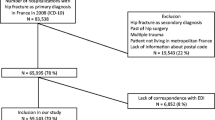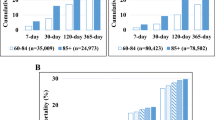Abstract
Summary
Deprivation predicts increased hip fracture risk. Over 14 years, hip fracture incidence increased among men with persisting inequalities. Among women, inequalities in incidence were less pronounced; whilst incidence decreased overall, this improvement was seen marginally less in women from the most deprived areas. Hip fracture prevention programmes have not reduced inequalities.
Purpose
Deprivation is associated with increased hip fracture risk. We examined the effect of area-level deprivation on hip fracture incidence in England over 14 years to determine whether inequalities have changed over time.
Methods
We used English Hospital Episodes Statistics (2001/2002–2014/2015) to identify hip fractures in adults aged 50+ years and mid-year population estimates (2001–2014) from the Office for National Statistics. The Index of Multiple Deprivation measured local area deprivation. We calculated age-adjusted incidence rate ratios (IRR) for hip fracture, stratified by gender and deprivation quintiles.
Results
Over 14 years, we identified 747,369 hospital admissions with an index hip fracture; the number increased from 50,640 in 2001 to 55,092 in 2014; the proportion of men increased from 22.2% to 29.6%. Whereas incidence rates decreased in women (annual reduction 1.1%), they increased in men (annual increase 0.6%) (interaction p < 0.001). Incidence was higher in more deprived areas, particularly among men: IRR most vs. least deprived quintile 1.50 [95% CI 1.48, 1.52] in men, 1.17 [1.16, 1.18] in women. Age-standardised incidence increased for men across all deprivation quintiles from 2001 to 2014. Among women, incidence fell more among those least compared to most deprived (year by deprivation interaction p < 0.001).
Conclusions
Deprivation is a stronger relative predictor of hip fracture incidence in men than in women. However, given their higher hip fracture incidence, the absolute burden of deprivation on hip fractures is greater in women. Despite public health efforts to prevent hip fractures, the health inequality gap for hip fracture incidence has not narrowed for men, and marginally widened among women.



Similar content being viewed by others
References
Royal College of Physicians (2016) National Hip Fracture Database annual report 2016. RCP, London
Keene GS, Parker MJ, Pryor GA (1993) Mortality and morbidity after hip fractures. BMJ 307(6914):1248–1250
Katsoulis M, Benetou V, Karapetyan T, Feskanich D, Grodstein F, Pettersson-Kymmer U et al (2017) Excess mortality after hip fracture in elderly persons from Europe and the USA: the CHANCES project. J Intern Med 281(3):300–310
Center JR, Nguyen TV, Schneider D, Sambrook PN, Eisman JA (1999) Mortality after all major types of osteoporotic fracture in men and women: an observational study. Lancet 353(9156):878–882
Leal J, Gray AM, Prieto-Alhambra D, Arden NK, Cooper C, Javaid MK et al (2016) Impact of hip fracture on hospital care costs: a population-based study. Osteoporos Int 27(2):549–558
Brennan SL, Henry MJ, Kotowicz MA, Nicholson GC, Zhang Y, Pasco JA (2011) Incident hip fracture and social disadvantage in an Australian population aged 50 years or greater. Bone 48(3):607–610
Brennan SL, Yan L, Lix LM, Morin SN, Majumdar SR, Leslie WD (2015) Sex- and age-specific associations between income and incident major osteoporotic fractures in Canadian men and women: a population-based analysis. Osteoporos Int 26(1):59–65
Oliveira CM, Economou T, Bailey T, Mendonca D, Pina MF (2015) The interactions between municipal socioeconomic status and age on hip fracture risk. Osteoporos Int 26(2):489–498
Farahmand BY, Persson PG, Michaelsson K, Baron JA, Parker MG, Ljunghall S (2000) Socioeconomic status, marital status and hip fracture risk: a population-based case-control study. Osteoporos Int 11(9):803–808
Bacon WE, Hadden WC (2000) Occurrence of hip fractures and socioeconomic position. J Aging Health 12(2):193–203
Zingmond DS, Soohoo NF, Silverman SL (2006) The role of socioeconomic status on hip fracture. Osteoporos Int 17(10):1562–1568
Reyes C, Garcia-Gil M, Elorza JM, Fina-Aviles F, Mendez-Boo L, Hermosilla E et al (2015) Socioeconomic status and its association with the risk of developing hip fractures: a region-wide ecological study. Bone 73:127–131
Wu TY, Jen MH, Bottle A, Liaw CK, Aylin P, Majeed A (2011) Admission rates and in-hospital mortality for hip fractures in England 1998 to 2009: time trends study. J Public Health 33(2):284–291
Quah C, Boulton C, Moran C (2011) The influence of socioeconomic status on the incidence, outcome and mortality of fractures of the hip. J Bone Joint Surg 93(6):801–805
Smith P, Ariti C, Bardsley M (2013) Focus on hip fracture: trends in emergency admissions for fractured neck of femur, 2001 to 2011. The Health Foundation and Nuffield Trust
Curtis EM, van der Velde R, Moon RJ, van den Bergh JP, Geusens P, de Vries F et al (2016) Epidemiology of fractures in the United Kingdom 1988-2012: variation with age, sex, geography, ethnicity and socioeconomic status. Bone 87:19–26
Court-Brown CM, Aitken SA, Ralston SH, McQueen MM (2011) The relationship of fall-related fractures to social deprivation. Osteoporos Int 22(4):1211–1218
West J, Hippisley-Cox J, Coupland CA, Price GM, Groom LM, Kendrick D et al (2004) Do rates of hospital admission for falls and hip fracture in elderly people vary by socio-economic status? Public Health 118(8):576–581
Peters SA, Huxley RR, Woodward M (2014) Do smoking habits differ between women and men in contemporary Western populations? Evidence from half a million people in the UK Biobank study. BMJ Open 4(12):e005663
Wilsnack RW, Wilsnack SC, Kristjanson AF, Vogeltanz-Holm ND, Gmel G (2009) Gender and alcohol consumption: patterns from the multinational GENACIS project. Addiction 104(9):1487–1500
National Osteoporosis Society (2015) Effective secondary prevention of fragility fractures: clinical standards for fracture liaison services. National OsteoporosisSociety, Camerton.
Crisp A, Dixon T, Jones G, Cumming RG, Laslett LL, Bhatia K et al (2012) Declining incidence of osteoporotic hip fracture in Australia. Arch Osteoporos 7:179–185
Leslie WD, O'Donnell S, Jean S, Lagace C, Walsh P, Bancej C et al (2009) Trends in hip fracture rates in Canada. JAMA 302(8):883–889
Brauer CA, Coca-Perraillon M, Cutler DM, Rosen AB (2009) Incidence and mortality of hip fractures in the United States. JAMA 302(14):1573–1579
Balasegaram S, Majeed A, Fitz-Clarence H (2001) Trends in hospital admissions for fractures of the hip and femur in England, 1989-1990 to 1997-1998. J Public Health Med 23(1):11–17
Neuburger J, Wakeman R (2016) Is the incidence of hip fracture increasing among older men in England? J Epidemiol Community Health 70(10):1049–1050
van der Velde RY, Wyers CE, Curtis EM, Geusens PP, van den Bergh JP, de Vries F et al (2016) Secular trends in fracture incidence in the UK between 1990 and 2012. Osteoporos Int 27(11):3197–3206
Bender AM, Kawachi I, Jorgensen T, Pisinger C (2015) Neighborhood deprivation is strongly associated with participation in a population-based health check. PLoS One 10(6):e0129819
Health and Social Care Information Centre (2017) Hospital episodes statistics data dictionary: admitted patient care. http://content.digital.nhs.uk/media/25188/DD-APC-V10/pdf/DD-APC-V10.pdf.Accessed 17 March 2017
Department for Communities and Local Government (2011) The English indices of deprivation 2010. Department for Communities and Local Government, London
Armitage JN, van der Meulen JH (2010) Identifying co-morbidity in surgical patients using administrative data with the Royal College of Surgeons Charlson Score. Br J Surg 97(5):772–781
Carstairs V, Morris R (1989) Deprivation and mortality: an alternative to social class? Community Med 11(3):210–219
Hiscock R, Bauld L, Amos A, Fidler JA, Munafo M (2012) Socioeconomic status and smoking: a review. Ann N Y Acad Sci 1248:107–123
Huckle T, You RQ, Casswell S (2010) Socio-economic status predicts drinking patterns but not alcohol-related consequences independently. Addiction 105(7):1192–1202
Kanis J, Johnell O, Gullberg B, Allander E, Elffors L, Ranstam J et al (1999) Risk factors for hip fracture in men from southern Europe: the MEDOS study. Mediterranean Osteoporosis Study. Osteoporos Int 9(1):45–54
Public Health England (2013) Social and economic inequalities in diet and physical activity. Public Health England, London
Zhang Q, Wang Y (2004) Socioeconomic inequality of obesity in the United States: do gender, age, and ethnicity matter? Soc Sci Med 58(6):1171–1180
Tang X, Liu G, Kang J, Hou Y, Jiang F, Yuan W et al (2013) Obesity and risk of hip fracture in adults: a meta-analysis of prospective cohort studies. PLoS One 8(4):e55077
Department of Health (2004) Choosing Health: making healthier choices easier. Her Majesty's Stationery Office, London
Department of Health (2010) Healthy lives, healthy people: our strategy for public health in England
Marmot M (2010) Fair society, healthy lives: strategic review of health inequalities in England post-2010. University College London, London
National Institute for Health and Care Excellence (2012) Osteoporosis: assessing the risk of fragility fracture (Clinical Guideline 146). https://www.nice.org.uk/guidance/cg146. Accessed 17 March 2017
National Institute for Health and Care Excellence. Clinical knowledge summaries: osteoporosis—prevention of fragility fractures. https://cks.nice.org.uk/osteoporosis-prevention-of-fragility-fractures. Accessed 17 March 2017
Kanis JA, Svedbom A, Harvey N, McCloskey EV (2014) The osteoporosis treatment gap. J Bone Miner Res 29(9):1926–1928
Klop C, Gibson-Smith D, Elders PJ, Welsing PM, Leufkens HG, Harvey NC et al (2015) Anti-osteoporosis drug prescribing after hip fracture in the UK: 2000-2010. Osteoporos Int 26(7):1919–1928
Royal College of Physicians. The Falls and Fragility Fracture Audit Programme (FFFAP). http://www.fffap.org/FFFAP/landing.nsf/index.html. Accessed 17 March 2017
Åkesson K, Marsh D, Mitchell PJ, McLellan AR, Stenmark J, Pierroz DD, Kyer C, Cooper C, IOF Fracture Working Group (2013) Capture the fracture: a best practice framework and global campaign to break the fragility fracture cycle. Osteoporosis Int 24(8):2135–2152.
Gullberg B, Johnell O, Kanis JA (1997) World-wide projections for hip fracture. Osteoporos Int 7(5):407–413
Bliuc D, Nguyen ND, Milch VE, Nguyen TV, Eisman JA, Center JR (2009) Mortality risk associated with low-trauma osteoporotic fracture and subsequent fracture in men and women. JAMA 301(5):513–521
Jennings LA, Auerbach AD, Maselli J, Pekow PS, Lindenauer PK, Lee SJ (2010) Missed opportunities for osteoporosis treatment in patients hospitalized for hip fracture. J Am Geriatr Soc 58(4):650–657
Hussain S, Gunnell D, Donovan J, McPhail S, Hamdy F, Neal D et al (2008) Secular trends in prostate cancer mortality, incidence and treatment: England and Wales, 1975-2004. BJU Int 101(5):547–555
Shahinian VB, Kuo YF, Freeman JL, Goodwin JS (2005) Risk of fracture after androgen deprivation for prostate cancer. N Engl J Med 352(2):154–164
Office for National Statistics. Adult drinking habits in Great Britain (2014) https://www.ons.gov.uk/peoplepopulationandcommunity/healthandsocialcare/drugusealcoholandsmoking/datasets/adultdrinkinghabits. Accessed 8 March 2017
Department for Health (2012) Long term conditions compendium of information: Third Edition https://www.gov.uk/government/uploads/system/uploads/attachment_data/file/216528/dh_134486.pdf.Accessed 18 March 2017
Schafer I, Hansen H, Schon G, Hofels S, Altiner A, Dahlhaus A et al (2012) The influence of age, gender and socio-economic status on multimorbidity patterns in primary care. First results from the multicare cohort study. BMC Health Serv Res 12:89
Li J, Green M, Kearns B, Holding E, Smith C, Haywood A et al (2016) Patterns of multimorbidity and their association with health outcomes within Yorkshire, England: baseline results from the Yorkshire Health Study. BMC Public Health 16:649
Nymark T, Lauritsen JM, Ovesen O, Rock ND, Jeune B (2006) Short time-frame from first to second hip fracture in the Funen County Hip Fracture Study. Osteoporos Int 17(9):1353–1357
Acknowledgements
The authors acknowledge Susan Charman for access to the Stata code that she developed for calculating the Royal College of Surgeons Charlson score. AB is supported by the Linda Edwards Memorial PhD studentship funded by the National Osteoporosis Society. CLG is funded by Arthritis Research UK (grant ref. 20000). YBS’s and TJ’s time is supported by the National Institute for Health Research (NIHR) Collaboration for Leadership in Applied Health Research and Care West (CLAHRC West) at University Hospitals Bristol NHS Foundation Trust. JN is funded by an NIHR post-doctoral Fellowship (PDF-2013-06-078). The views expressed in this publication are those of the authors and not necessarily those of the NHS, the National Institute for Health Research or the Department of Health.
Author information
Authors and Affiliations
Corresponding author
Ethics declarations
We obtained NHS Research Ethics Committee approval for this study (REC reference: 15/LO/1056).
Conflict of interest
None.
Rights and permissions
About this article
Cite this article
Bhimjiyani, A., Neuburger, J., Jones, T. et al. The effect of social deprivation on hip fracture incidence in England has not changed over 14 years: an analysis of the English Hospital Episodes Statistics (2001–2015). Osteoporos Int 29, 115–124 (2018). https://doi.org/10.1007/s00198-017-4238-2
Received:
Accepted:
Published:
Issue Date:
DOI: https://doi.org/10.1007/s00198-017-4238-2




